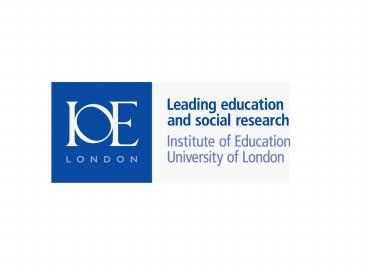Inside the black box: Raising standards through classroom assessment - PowerPoint PPT Presentation
1 / 17
Title:
Inside the black box: Raising standards through classroom assessment
Description:
Low Yes (bad) Teacher's provision of instructional support. Poor behaviour ... Administrators need it so they can make good decisions about supporting teacher change ... – PowerPoint PPT presentation
Number of Views:336
Avg rating:3.0/5.0
Title: Inside the black box: Raising standards through classroom assessment
1
(No Transcript)
2
How can we make productive contributions to
policy and practice?
- IEE Interim Strategy Board awayday
- 13 May 2008
- Dylan Wiliam
3
Pasteurs quadrant
4
Institute for Effective Engineering
- Building a bridge
- Requires a knowledge of the fundamental
properties of materials - But the physics doesnt tell you what the bridge
should look like - Designing effective learning environments
- Requires a knowledge of the fundamental
principles of psychology - But the psychology doesnt tell you what the
learning environment should look like
5
Looking in the wrong place
- 3 generations of effectiveness research
- Raw results approaches
- Different schools get different results
- Conclusion Schools make a difference
- Demographic-based approaches
- Demographic factors account for most of the
variation - Conclusion Schools dont make a difference
- Value-added approaches
- School-level differences in value-added are
relatively small - Classroom-level differences in value-added are
large - Conclusion An effective school is little more
than a school full of effective classrooms
6
Teacher quality matters
Barber Mourshed, 2007
7
but more for some than others
Impact of teacher quality on student outcomes
(Hamre Pianta, 2005))
8
The dark matter of teacher quality
- Teachers make a difference
- But what makes the difference in teachers?
9
Why research hasnt changed teaching (much)
- Aristotles main intellectual virtues
- Episteme knowledge of universal truths
- Techne ability to make things
- Phronesis practical wisdom
- In education, what works is often the wrong
question - Almost everything works somewhere
- Almost nothing works everywhere
- So the smart question is usually under what
conditions will this work? - And therefore much expertise in education is
phronesis, not episteme - Dissemination might be the right metaphor for
episteme, but not phronesis - How do we decide whether we need episteme or
phronesis - In medicine?
- In education?
10
After Nonaka Tageuchi, 1995
11
Designing for scale
- In-principle scalability
- A single model for the whole school
- But which honours subject-specificities
- Understanding what it means to scale (Coburn,
2003) - Depth
- Sustainability
- Spread
- Shift in reform ownership
- Consideration of the diversity of contexts of
application - Clarity about components, and the theory of action
12
Two opposing factors in any school reform
- Need for flexibility to adapt to local
conditions, resources, etc - Implies there is appropriate flexibility built
into the reform - Need to maintain fidelity to core principles, or
theory of action of the reform, if it is to
achieve desired outcomes - Implies you have a well-thought-out theory of
action
13
Tight but loose
Some reforms are too loose (e.g., the Effective
schools movement) Others are too tight (e.g.,
Montessori Schools) The tight but loose
formulation
combines an obsessive adherence to central
design principles (the tight part) with
accommodations to the needs, resources,
constraints, and particularities that occur in
any school or district (the loose part), but
only where these do not conflict with the theory
of action of the intervention.
14
Why the why?
- In many reforms, the why is non-existent,
under-conceptualized, or not communicated well - The Tight but Loose framework says
- It is imperative to explicitly weave the why (the
theory of action and research base) into the what
and the how, so that end users understand it - Without that knowledge, under inevitable local
pressures and constraints, users will make
implementation decisions that undercut the
effectiveness of the reform
15
Logic model for KLT
(Leahy, Leusner Lyon, 2005)
16
The theory of action matters to everyoneor it
should
- Teachers need it so they can make good decisions
about the selection and adaptation of AfL
techniques - Administrators need it so they can make good
decisions about supporting teacher change - Parents need it because otherwise theyre nervous
about new practices - Politicians need it so they can make good
decisions (fund programs that work and set
policies that support them)
17
The effects of context
- Beliefs
- about what constitutes learning
- in the value of competition between students
- in the value of competition between schools
- that test results measure school effectiveness
- about the trustworthiness in numerical data, with
bias towards a single number - that the key to schools effectiveness is strong
top-down management - that teachers need to be told what to do, or
conversely that they have all the answers - In the English context, which beliefs
- are most significant for education reform?
- can we change?































